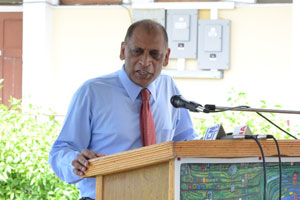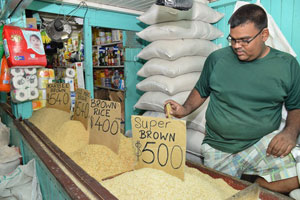AGRICULTURE Minister, Dr. Leslie Ramsammy has debunked detractors amidst their levelling raging criticisms of the rice industry when he expounded on the success of the sector, tracing the amazing recovery of the rice industry under the People’s Progressive Party/Civic (PPP/C) Government all the way to its present status.
PPP’S EARLY SUCCESS NOT MAINTAINED BY PNC
During a recent interview on the National Communications Network, the minister first recounted how early post-Independence Guyana fared well in the rice sector. He declared that 200,000 tonnes were achieved in 1964; and, for the first time, 100,000 tonnes were exported in that same year. And that was during the 1957/1964 PPP Government!
According to Dr. Ramsammy, there was a drop from this lofty height, and Guyana did not again produce 200,000 tonnes of rice until 1995. And indeed, “we only reached 100,000 tonnes in export once between 1964 and 1992,” he said.
In other words, the minister’s clear portrayal was that rice crumbled under the People’s National Congress (PNC), and Guyana managed to export 104,000 tonnes only in 1978.
VARIOUS BRANDS OF GUYANESE RICE
However, barring this lone bright spot, the PNC allowed the rice sector to become virtually dead; but since 1992, “rice has just parachuted upwards, and we now have a production of 635,000 tonnes last year”, Dr. Ramsammy said.
“That is a number that, just ten years ago, people said was impossible for Guyana; and so far for this crop of 2015, when we have so far harvested 25 per cent of the crop, if the production continues to the end of this first crop, we will produce more than 350,000 tonnes of rice, which is more in one crop than we did (at) any time in the period before 1992!” Dr. Ramsammy declared.
IRREFUTABLE SUCCESS
In January of this year, 45,000 tonnes of rice were exported; which is more in this first quarter than had been exported at any time in any year between 1964 and 1992, and is irrefutable evidence that the industry is flourishing. Overall, in 2014, the country exported 501,000 tonnes.
Dr. Ramsammy elaborated that, in Essequibo, Guyana is producing more rice now than at any previous time in its history. Figures show that, by 1990, “we were only cultivating about 30,000 acres; but now we are cultivating in Essequibo (alone) around 38,000 hectares!” (One hectare is 2.47 acres)
Minister Ramsammy detailed that after the figures had been compiled, growth of more than 100 per cent had been realised. He also mentioned that the success is more than in numbers, as, in Essequibo before 1992, more than half of the rice produced was by one entity – the Kayman Sankar Group of Companies. Today, 100 per cent of the production in Essequibo comes from thousands of farmers. This takes the success of rice into a new dimension, where monopoly and exploitation have been erased.
This important dimension, he said, is sometimes missed by the Opposition; but, he challenged, “People (should) take a step back and recognise that, indeed, before 1992, we had very few mills in the country, and that production was not there to support the mills.”
He recapped that, at this juncture, there was little to show in terms of infrastructure, but today there are large mills; and whether it’s Essequibo, Regions Three, Four, Five or Six, there are mills that produce quality rice that could enter any market in the world.
Referring to the Venezuelan market that excites everyone, the minister declared: “If we had this market in 1992, we could not sell to Venezuela, because the quality of the mills that we had could not process paddy to produce the rice that Venezuela buys.”
He added that virtually all of the paddy that is produced in Essequibo can meet the quality that is required, and in every way whatsoever.
GOVERNMENT’S ROLE
Minister Ramsammy rubbished the Opposition’s idea that ‘the Government should step aside’, and that ‘rice is a private sector business.’ He poignantly queried: “Will the farmers invest in all of this?”
He made it clear that Government has a responsibility to accommodate growth of the rice industry, and if it were to remove the investments it is making, then rice would die again.
He cited a situation that obtains during the dry season, when the irrigation pumps have to provide the farmers with water as a public good.
 He pointed out that the pumps which had been established by the late Dr. Cheddi Jagan in 1957 and 1964 had either been disabled or were malfunctioning during the tenure of the PNC; but, he said, “The PPP/C Government did resuscitation work, and so today, even in an extreme dry season, we may not be able to give the farmers all the water they want, but we meet their demands so that the rice industry is not destroyed.”
He pointed out that the pumps which had been established by the late Dr. Cheddi Jagan in 1957 and 1964 had either been disabled or were malfunctioning during the tenure of the PNC; but, he said, “The PPP/C Government did resuscitation work, and so today, even in an extreme dry season, we may not be able to give the farmers all the water they want, but we meet their demands so that the rice industry is not destroyed.”
Government is presently building a pump station at Lima, he said, and even though a pump station had been installed at Three Friends, a new one is being budgeted for.
The minister added that not only the ‘pump inputs’ but also the main canal linking the conservancy had to be seriously worked on, as “this was almost non-functional, and all the head regulators were disabled.”
Dr. Ramsammy mentioned that, under an Inter-American Development Bank loan, this Government replaced all of the head regulators, and has maintained the main canals even as “those very maintenance activities are continuing to be an issue with the Opposition.”
MARKET AVAILABILITY
Before 1992, Dr. Ramsammy said, Guyana sold rice to only a few European countries and some Caribbean states. He tied this reality to the fact that, during these years, Guyana did not need more (markets) because the production was low, sufficing for the few markets.
Conversely, the minister declared, the market size then could not take up even half of a crop of current production.
Today, the minister detailed, production and market are in great equilibrium, and now “we export to more European countries than we have ever done before. We export to more Caribbean countries, because some Caribbean countries were buying rice from the US and are now buying from Guyana. We export to more South American countries — Brazil, Chile, Colombia: we export to Central America, which we never did before, and not just Panama: we export to Guatemala, Nicaragua, El Salvador. And as we speak, we are at the (stage of concluding) arrangements with African countries.”
Minister Ramsammy noted that the business and economic sides of this kind of large-scale export are well taken care of, and that “draft contracts are available for these new countries, and we are looking at the banking arrangements to make sure that we get paid.”
The minister explained that the expanded market means that “all our eggs are not in one basket”, and that Guyana has to always be prepared that, if something should go wrong in one place, the industry will not crumble.
VALUE-ADDED RICE
Minister Ramsammy paid tribute to the Government’s prudence in regard to the rice sector, in that there were calculated moves to ensure that both quantity and quality, as well as variety, be amalgamated.
From 1995 to now, the country has produced 14 new varieties of rice, paddy for Guyana, and recently, “we introduced GRDB 14, and in 300 acres, where it is now on farmers’ plots, including in Essequibo; and the average is between 55 and 60 bags per acre.
“GRDB 13 is the aromatic rice; and GRDB 12, 11, 10 are still very popular across Guyana.”
In sharp contrast, the minister noted, before 1992 this was not possible. He recalled the Rustic (the extra-long grain, high quality locally-developed rice variety) that was developed by an Indian scientist in Guyana. He said this contribution under the then PNC Government was short-lived, as the PNC revoked (the developer’s visa) and sent him home.
NO VALIDITY PEDDLED
Minister Ramsammy advised that when there are criticisms from the Opposition, stating that “we have high production but no markets, they ignore the fact that last year we sold 501,000 tonnes and we had 33 countries”; and therefore there is no validity to what is being peddled.
He further elaborated that people need to realise that rice is one of the most common commodities in the world, but many of these markets demand high-quality rice, and that means that millers must ensure they are sending the best quality of rice, or their reputation will be affected.
This, he said, is what recently obtained with Alesie, having shipped substandard rice to Chile; and that circumstance had a huge negative impact on Guyana’s reputation.
He singled out Mr. Turhane Doerga as “having done Guyana a disservice by jeopardising that particular market, and now we have to go and make sure we do everything; so we are starting back this year from scratch, and we have to go and make sure we bring rice into Chile and show them that Guyana has high-quality rice, and they should not nurture an image in their mind that Guyana’s rice is just bricks, wood and chips.”
The minister also recalled that Mr. Doerga had a questionable entry into the rice sector. He said that under the PNC, Anna Regina, Somerset-and-Berks, Black Bush Polder, Wakenaam, and in fact the entire major mills except Kayman Sankar, were owned by the Government. At this juncture Mr. Doerga came to Guyana, and “Mr. Desmond Hoyte literally handed him over the rice industry, and I don’t know how much he paid, I don’t know if he paid, but he afterward kept borrowing money, and “I think the amount of money was around US$34M.”
This irresponsible and spendthrift approach, he said, led to a 2006 litigation against Mr. Doerga in Florida.
“He was taken to court because he had not paid back his money, and that court decision was an interim judgment for $8M. And then, in 2013, there was another court judgment for another $12M plus interest; and later, in 2013, an order from the judge was for the arrest of Mr. Doerga anytime he appears in Florida.”
In wrapping up his arguments, Minister Ramsammy appealed to Guyanese — and rice farmers in particular — to be careful of persons who spread all kinds of stories and confuse their minds.




.png)









